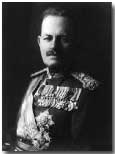Who's Who - Sir Julian Byng
 Julian Hedworth George Byng (1862-1935)
was born at Wrotham Park on 11 September 1862. After studying at Eton
Byng began a military career that took him to the Sudan and then to South
Africa, where he served in the Second Boer War of 1899-1901. During
the latter campaign he proposed to Marie Evelyn Moreton; they were married
following the war on 30 April 1902.
Julian Hedworth George Byng (1862-1935)
was born at Wrotham Park on 11 September 1862. After studying at Eton
Byng began a military career that took him to the Sudan and then to South
Africa, where he served in the Second Boer War of 1899-1901. During
the latter campaign he proposed to Marie Evelyn Moreton; they were married
following the war on 30 April 1902.
With the onset of the First World War, Byng served as commander of the Cavalry Corps within the British Expeditionary Force (BEF) under Commander-in-Chief Sir John French.
Sent to serve as commander of 9th Army Corps in the ill-fated Dardanelles campaign, Byng was one of few to emerge with an enhanced reputation, having successfully overseen the withdrawal from Suvla Bay.
In 1916 he was given charge of the Canadian Army Corps. Following victory at Vimy Ridge in April 1917 Byng was promoted to command of Third Army as a full general in June, where he helped devise and executed the attack at Cambrai which, although ultimately unsuccessful, achieved rapid initial progress with an early use of tanks, leading to the ringing of church bells at home in Britain for the first time during the war, greatly enhancing Byng's reputation.
Byng served out the remaining months of the war with a string of victories at Albert, Epehy, Havrincourt and Valenciennes.
Following the armistice he was raised to the peerage as 1st Baron Byng of Vimy of Thorpe-le-Soken, in Essex, on October 7, 1919.
He served as Governor General of Canada from 1921-26, and as commissioner of the London Metropolitan Police from 1928-31. Following a promotion to Field Marshal in 1932, Byng retired to Essex with his wife, where he died on 6 June 1935.
German losses at Messines were 25,000, of which 7,500 were taken prisoner. British casualties were 17,000 killed or wounded.
- Did you know?
